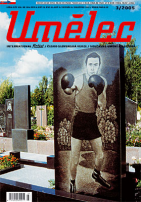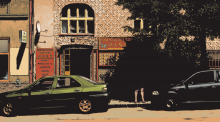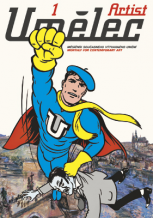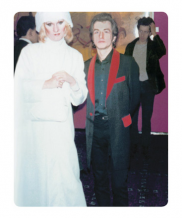| Umělec 2005/3 >> SOUNDS LIKE ART | Просмотр всех номеров | ||||||||||||
|
|||||||||||||
SOUNDS LIKE ARTUmělec 2005/301.03.2005 Tony Ozuna | sound art | en cs de es |
|||||||||||||
|
Kim Gordon, of Sonic Youth, expresses a common feeling while interviewing Rodney Graham, a Canadian multimedia artist, for Bomb Magazine. She says, “The thing about music that I find so interesting, not to be pompous about it, is that it’s like architecture. You carry it with you; it changes your mood. It transforms whatever environment you’re in, and it transforms your inner environment, your psyche. It’s that quality that’s so hard to describe. Nothing else is like it. I leave stores because I can’t stand the music.”
As for me, I won’t enter taxis if the music is too loud and stupid, and ditto for restaurants and cafes. (You may be thinking, that I have nowhere to go in Prague, and that’s almost true.) In the case of galleries, I’m a sound conservative, which means I have no tolerance for the chatting and gossiping by the people guarding the art. Sometimes I will ask them to lower their voices, which upsets them, so they either speak louder, or shut up but follow me around, breathing down my neck for the rest of the time. I like to experience exhibits in silence—I should bring earmuffs to galleries just to make my point. This doesn’t mean I didn’t appreciate the high number of recent art (winter-spring 2005) exhibits in Prague using sound. On the contrary: Tomas Hruza’s exhibit, Leinbrock Ideal ver.0.2 at the Communication Space, Školská 28, was an inventive interactive sound installation using software data and four antique coffee grinders. Visitors could turn the squeaky cranks on the coffee grinders, and this would generate digital sounds stored on a computer drive. This show offered the public a chance to improvise “music” as a quartet. (In May, Leibrock Ideal was upgraded to ver.0.3 and exhibited in Prague’s Entermediale 2—Festival of Art & New Technologies.) Then there was Objectually Speaking, a group exhibition of Sound Art at Futura featuring new and recent works by local and international artists, Mark Bain, E-AREA, Rocco Dubbini, Martin Janíček, Aleš Killian/Ladislav Zelený, Jana Matejková, and Silver. The curators of this show not ironically intended to rise against the “silence” of museums and art institutions, and other places which in general try to keep noise out, “minimizing the amount of external stimuli that can seep inside and cause disruption.” But what about the chatting old ladies in the corner, I must ask. If the curators of this show meant museums outside this country, then I can see the point. Otherwise, the artists general incorporation of low noises and found sound in this show was rather conservative, holding steadfast to the too long held principle of sound as art must always equal noise. On the other hand, though not really a sound piece, the harsh noise of Krištof Kintera’s copulating appliances and handtools in Super Natural Special Real at Prague’s Galerie Jiří švestka gallery pushed sound to its maximum effect. The high volume rattling, hammering, electrical buzzing, and banging non-stop had to drive the gallery’s staff mad after weeks of that. And for those just there for a visit, the industrious racket made by Kintera’s cute little sex machines was simply a good ear fuck. Moving away from noise, but still in the realm of sound, there was an interesting show at the Robert Guttman Gallery, by two Americans--composer, Robert Gluck, and visual artist, Cynthia-Beth Rubin. Their sound and visual project, Layered Histories, was an elaborate interactive work that projected the many layers of an illuminated Hebrew manuscript (the Marseilles Bible) as a beautiful, fragile art book, reflecting the convergence of cultures (Christianity, Islam, Jewish) in medieval Spain; it served as a narrative text of layered meanings with a subtle soundtrack or sound sculpture of found sound, noise, and music fragments from Jewish culture. Young Danish artist Pia Ronicke at Display similarly attempted to capture a convergence of cultures though in modern times with her installation Elysian Fields, a photo and video project filmed at Elysian Park in East Los Angeles—a largely un-kept park on the edge of one time notoriously dangerous ganglands, long-time Mexican and Asian immigrant neighborhoods in the process of being gentrified over the last few years. In Ronicke’s video, Duke Ellington plays on the radio (background music) for picnickers in Elysian Park, a common ground for the many diverse cultures—hipsters and immigrants over all. All of these shows relied on sound. Joseph Grigley, a deaf American artist who exhibited at Gandy Gallery did too, but his show had the strangest twist. “What happens to the memories of sound and voices when someone becomes deaf?” he asks. His show, titled, “Remembering Is a Difficult Job, but Somebody Has to Do It,” presented video and photographs playing off each other: photos of a deserted, tropical island, and icebergs, and a video of the artist sitting in front of a video camera, and singing in a coarse, almost unintelligible voice, the theme to “Gilligan’s Island,” a popular American comedy from the 60s. In another video Grigley garbles American TV jingles from the 60s—ads for Marlboro and Schlitz (American beer). Grigley was born with one ear deaf; he then became fully deaf at the age of ten when he fell down a hill and punctured his good ear. “Gilligan’s I sland” and the TV jingles are songs from Grigley’s childhood, which he remakes through the voice of his own memories and the memory of his voice. The use of music (songs) and particularly the use of the artist’s voice in song are considered tabo o by most artists and critics, and so those who do this are called “iconoclastic” as is Vancouver-based Rodney Graham who had a retrospective this winter at MOCA, the Museum of Contemporary Art in Los Angeles, presenting the full range of his use of media, which photos, musical compositions, video and film projects. The exhibition Rodney Graham: A Little Thought traces Graham’s journey as a multimedia artist who strongly identifies himself as a singer-songwriter. His devotion to his music is revealed from his early years as an art student with the punk band UJ3RK5 (pronounced “you jerks’), which included fellow art-students Jeff Wall, Ian Wallace, and the cyber-punk writer William Gibson, among others. His best-known work in this retrospective, which opens at the Institute of Contemporary Art (ICA) in Philadelphia in September, is Photokinetoscope (2001), which is partly inspired by Syd Barrett, the singer of Pink Floyd who died before the group finished their second record. At the age of 19, Barrret made a film document of his first acid trip, romping through the countryside of Cambridge. Similarly inspirational to Graham is Albert Hoffman, the inventor of LSD who dropped acid at his lab (in Basel), then rode his bicycle home. These two events are merged and re-enacted in Photokinetoscope, where Graham drops a tab of acid in the Tiergarten, the vast central park in Berlin. After dropping the acid, Graham calmly rides his bicycle through the park, stops to rest, drinks some tea from a thermos, looks around at nature and that’s it. Through sound and image, the viewer can only imagine the mind exploration in the artist’s head. The soundtrack to this five-minute film is a 15-minute record, a song written and performed by Graham to accompany the film. Nodding to Barrett’s psychedelic-pop influence, Graham’s song includes the memorable lyric “You're the kind of girl that fits in with my world,” from Barrett’s song “Bike.” The film is generated by the record, so when the viewer enters the room, he or she immediately sees just a turntable, a projector and a blank screen. The viewer must set the needle of the turntable onto the record to activate the projector. Since the record plays longer than the film, the film repeats in a loop, but with different sound image associations, so Graham’s elegant use of narrative, creating short films with beginnings, middles and ends is subverted in this work. Another film by Graham is Rambling Man (1999), a cross between a music video and a Marlboro commercial, where the artist resembling a cowboy, leisurely rides on horseback across a canyon toward the viewer, crosses a brook, dismounts then plays a song on his acoustic guitar. The song, “How I Became a Ramblin’ Man,” doesn’t actually tell the story of how Graham became such a journeyman, instead the artist’s lyrics tease with a story untold: “My father once told me, ‘When folks can bear the sight, of a solitary type, I’ll tell you how I came to be just a ramblin’ man’.” In other works, Graham just jams. Softcore (More Solo Guitar Music for the Love Scene, Zabriskie Point), 2001, replays a loop from the late 60s psychedelic film Zabriskie Point by Michelangelo Antonioni. Graham revives an infamous scene showing more than a dozen nude teenagers having sex in the desert, first as couples then in an orgy. Filmed in Death Valley, California, the movie scene’s soundtrack was recorded by Jerry Garcia, the late-guitarist of California’s legendary hippie band, the Grateful Dead. In Graham’s piece, the artist improvises on electric and acoustic guitar as Jerry Garcia did, playing psychedelic guitar for several hours over looped film footage of the desert love scene. Graham admits that in such works, he is literally seeking a voice that allows for more direct expression than his complexly layered works in other media. Because his work fully embraces rock and pop music, it is also antithetical to John Cage’s attitude to just let sounds be themselves. For many years, Cage’s approach was to steer clear of any sound that could be remotely enjoyed by even one person in the audience, and the majority of contemporary artists working with sound tend to follow this as a credo. Cage also said, “Everything we do is music,” and thus in his performances he incorporated not only radios, phonographs, and conventional musical instruments, but also the sound of a slamming door, so really any noise at all and most importantly, nothing at all. The essential, indisputable complement to sound, according to Cage, is silence. Which brings us back to the galleries of Prague, where absolute silence is unheard of and the use of sound in art still has its ups and downs.
01.03.2005
Рекомендуемые статьи
|
|||||||||||||
|
04.02.2020 10:17
Letošní 50. ročník Art Basel přilákal celkem 93 000 návštěvníků a sběratelů z 80 zemí světa. 290 prémiových galerií představilo umělecká díla od počátku 20. století až po současnost. Hlavní sektor přehlídky, tradičně v prvním patře výstavního prostoru, představil 232 předních galerií z celého světa nabízející umění nejvyšší kvality. Veletrh ukázal vzestupný trend prodeje prostřednictvím galerií jak soukromým sbírkám, tak i institucím. Kromě hlavního veletrhu stály za návštěvu i ty přidružené: Volta, Liste a Photo Basel, k tomu doprovodné programy a výstavy v místních institucích, které kvalitou daleko přesahují hranice města tj. Kunsthalle Basel, Kunstmuseum, Tinguely muzeum nebo Fondation Beyeler.
|





































 New book by I.M.Jirous in English at our online bookshop.
New book by I.M.Jirous in English at our online bookshop.
Комментарии
Статья не была прокомментированаДобавить новый комментарий